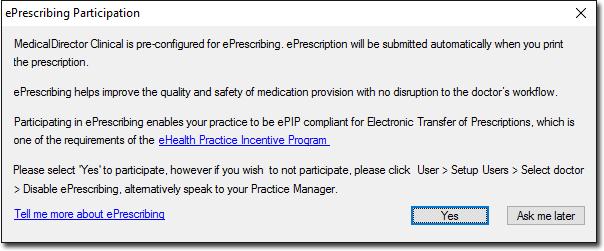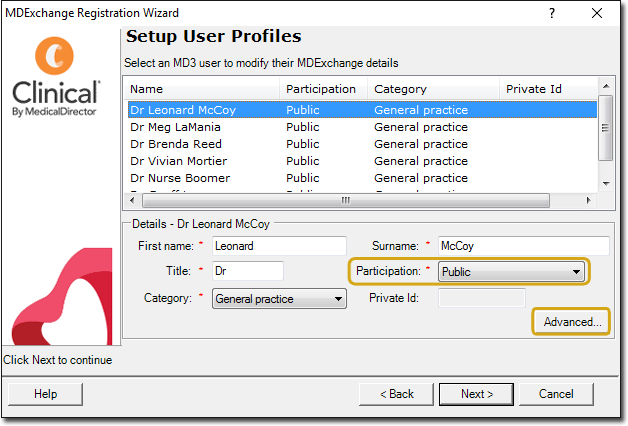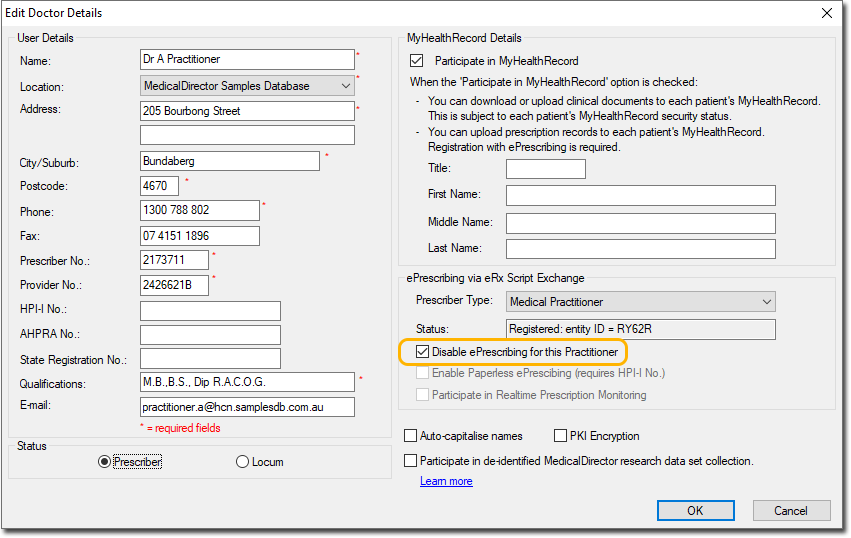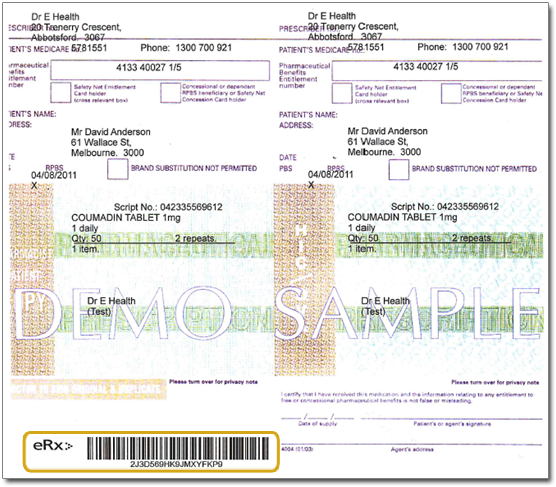Electronic Transfer or Prescriptions (eTP)
The practice must ensure that the majority of their prescriptions are sent electronically to a Prescription Exchange Service (PES)
Source: Medicare Practice Incentives Program eHealth Incentives Guidelines-February 2013
What is ePrescribing?
ePrescribing in Clinical is currently facilitated by eRx Script Exchange, an Australia-wide Internet-based gateway allowing prescriptions to be sent electronically and securely between practitioners and pharmacies. It has been developed to improve patient safety by ensuring that the information on a patient's prescription arrives exactly as intended. ePrescribing functionality is installed automatically with MedicalDirector Clinical, and must be configured manually.
How ePrescribing Works

Configuring ePrescribing in Clinical
The following screen appears when you first log into MedicalDirector Clinical, and if you have clicked the Ask me later button. If you click the Yes button, and you have not already registered for MDExchange, you will be prompted to set it up now. NOTE: Ensure you have an active Internet connection.
STEP 1: ePrescribing Participation Acceptance
When prompted, click  to participate.
to participate.

STEP 2: Registering for MDExchange
If your practice has already registered for MDExchange, please skip this step and proceed now to Step 3.
If you clicked Yes to the ePrescribing Participation prompt, the MDExchange Activation Registration prompt appears, as shown below.

Alternatively:
1. From the Clinical front screen, select Tools > MDExchange > Registration Wizard. The MDExchange Wizard Welcome screen appears.
2. Click the Next button to continue. The MDExchange Licence Agreement appears. Read the Licence agreement. If you agree to the Licence tick the I have read and accepted the agreement check box, and then click the I Agree button to continue. You will not be able to register until you have performed these actions.
3. The
MDExchange Server Connection
Setup window appears.

4. Click Next A test for connectivity is now performed, as indicated in the upper-right of the window. Only when a connection has been established successfully will you be able to proceed with the MDExchange Registration Wizard.
5. The
Contact Details window
appears. The practice details will automatically be populated
with those recorded in the Practice tab of Clinical Options. Confirm
that they are correct, and make changes as necessary. Note that
changes made here are saved back to the Practice tab of Clinical
Options.

6. Click
Next when
you are ready to continue. The Security
Options - Location window appears. Here you need to determine
which type of Certificates you will use for the digital signing
and encrypting of correspondence you send and receive via MDExchange.
Select the certificate type using the appropriate option.

The default and recommended certificates are MDExchange Certificates
(as shown above). Alternatively you can select HESA Certificates.
Note that you cannot select HeSA tokens (i-Keys) for Practice
encryption or signing because that would require the token to
be constantly available (plugged in) to the server computer. You
can edit the security options after MDExchange has been installed,
via the Clinical Front Screen > Tools > MDExchange >
Security.
7. Once
you have selected which certificates to use, click Next
to confirm your selection and continue. The Setup
User Profiles window appears.

Only practitioners in your Clinical User Database are able to register
for MDExchange. Here you have an opportunity to indicate which
practitioners will not have access. For those that do have access,
you can also specify how they will be listed in the MDExchange
Public Database, and what signing certificate they will use for
correspondence (via  ).
).
The Participation drop-down menu indicates Public participation
by default. To prevent this user from participating in MDExchange,
select the Do Not Participate option. Should you wish this user
to participate in MDExchange, you must select whether the user
should be publicly or privately listed.
o Being privately-listed in MDExchange means that the user is generated a Private ID. This user is added to the MDExchange public database and visible only to other registered users of MDExchange of their choosing, by giving them this private ID which is used as part of the search criteria for discovering that person. Note that the MDExchange system and functionality is only available to registered users.
o Being
publicly-listed in MDExchange means that the user will be added
to the MDExchange public database and are visible to other registered
users of MDExchange. Note that the MDExchange system and functionality
is only available to registered users.
8. Click
the  button to specify if you select a HESA token as the signing certificate
for a user, rather than the default, which is to use the practice's
signing certificate.
button to specify if you select a HESA token as the signing certificate
for a user, rather than the default, which is to use the practice's
signing certificate.
9. Make changes as necessary for each user, and click Next on the Setup User Profiles window when you are ready to continue. The Ready to Register window appears. Click Back if you need to go back through MDExchange Registration Wizard to review your settings.
10. When
you are ready to register MDExchange, click  . The MDExchange Registration Wizard attempts
to connect to the MDExchange server to validate and record your
settings. You must have an active Internet connection for this
process to succeed. You will be notified upon successful registration.
. The MDExchange Registration Wizard attempts
to connect to the MDExchange server to validate and record your
settings. You must have an active Internet connection for this
process to succeed. You will be notified upon successful registration.
STEP 3: Configure ePrescribing – Practitioner Configuration
1. From the Clinical front screen, select User > Setup Users. The User Database window appears.
2. Locate
and double-click the record of the practitioner who you wish to
enable ePrescribing for. The Edit
Doctor Details window appears.

3. If necessary, remove the tick from the Disable ePrescribing for this Practitioner check box.
Important Resources
o eRx Script Exchange
https://www.erx.com.au/
o NEHTA
PIP Implementation Overviews > Electronic Transfer of prescriptions
http://www.NEHTA.gov.au/pip
o Electronic
prescribing and dispensing of medicines
http://www.medicareaustralia.gov.au/provider/pbs/pharmacists/dispense.jsp
